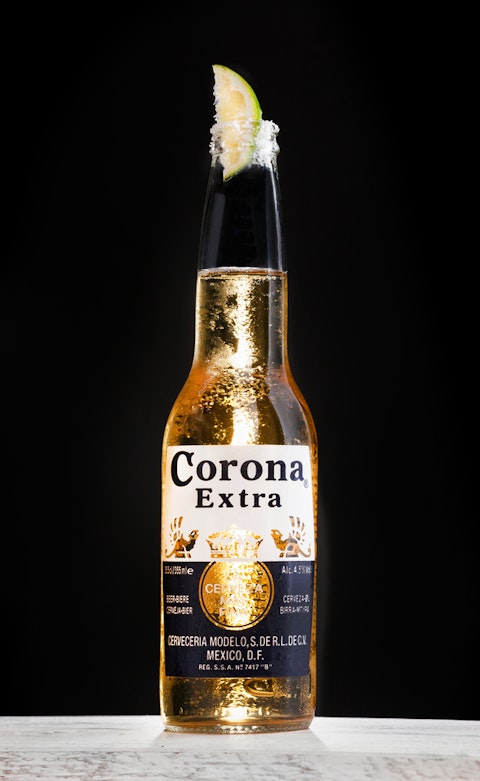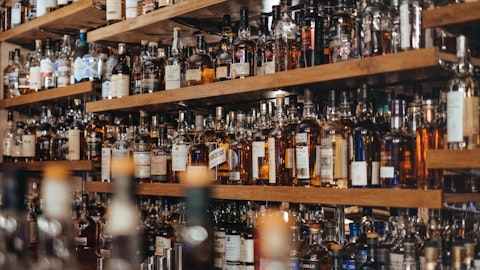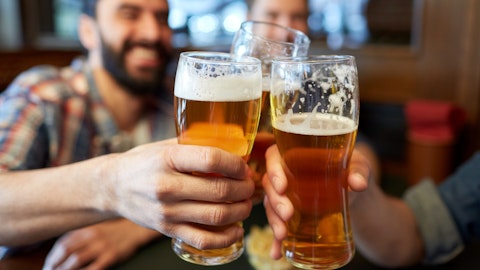Constellation Brands, Inc. (NYSE:STZ) Q1 2024 Earnings Call Transcript June 30, 2023
Constellation Brands, Inc. misses on earnings expectations. Reported EPS is $2.66 EPS, expectations were $2.83.
Operator: Hello, and welcome to the Constellation Brands Q1 Fiscal Year 2024 Earnings Call and Webcast. [Operator Instructions] As a reminder, this conference call is being recorded. It’s now my pleasure to turn the call over to Joe Suarez, Vice President, Investor Relations. Please go ahead, Joe.
Joe Suarez: Thank you, Kevin. Good morning, all, and welcome again to Constellation Brands’ Q1 fiscal 2024 conference call. I’m here this morning with Bill Newlands, our CEO; and Garth Hankinson, our CFO. As a reminder, reconciliations between the most directly comparable GAAP measure and any non-GAAP financial measures discussed on this call are included in our news release or otherwise available on the company’s website at www.cbrands.com. Please refer to the news release and Constellation’s SEC filings for risk factors, which may impact forward-looking statements made on this call. Following the call, we’ll once again be making available in the Investors section of our company’s website, a series of slides with key highlights of the prepared remarks shared by Bill and Garth in today’s call.
Before turning the call over to Bill, in line with prior quarters, I’d like to ask that we limit everyone to one question per person as noted, which will help us end our call on time. Thanks in advance, and now here’s Bill.
Bill Newlands: Thanks, Joe, and good morning, everyone. We are off to a strong start in fiscal 2024, with a solid first quarter. Our Beer Business delivered net sales growth of 11%, mainly driven by continued strong volume growth in line with our medium-term algorithm. As anticipated, depletion performance accelerated throughout the quarter, resulting in a 5.5% increase for the period and acceleration that has continued into June, supported by our beer team’s unrelenting push to increase distribution for our high-growth, high-velocity brands, continued incremental investments in marketing focused on the highest return opportunities and ongoing strong demand for our high-end Mexican beer brands aligned with consumer-led premiumization trends.
Particularly in large markets with significant runway for Modelo Especial, like Texas, Florida, Illinois and North Carolina with the brand posted double-digit dollar sales growth in Circana track channels. And yes, also in California, where our share gains actually accelerated and as expected, demand for our portfolio did ramp up after the unseasonably cold weather in early March. All in, our Beer Business delivered strong growth for the quarter, while consistently advancing all four areas of our strategic initiatives. First, the business continued to propel its powerful core brands that people love. Modelo Especial remained the number one dollar share gainer in the entire beer category, delivered double-digit dollar sales growth in tracked channels, and as most of you likely already are aware, became the number one beer in America in dollar sales during the first quarter.
Both Corona Extra and Pacifico also achieved share gains and delivered dollar sales growth of approximately 4% and 26%, respectively. Second, our beer innovations, which are still centered around the flavor and betterment consumer-led trends are off to a great start. Our Modelo Chelada brands remained a top 10 dollar share gainer with further support from our variety pack launched last year, the number four new product in Circana channels and from the launch of new Sandía Picante flavor, the number five new brand. Modelo Oro was also a top 10 share gainer and incrementally has actually been slightly above what we saw in initial test markets. And Corona NA was the number one share gainer in the non-alcoholic beer category in tracked channels.
Third, the expansions of our beer brewing capacity continued to advance as planned. Our latest modular addition to Obregon successfully ramped up in Q1 and we are on track with the new ABA facility at Nava for Q4 of this fiscal year. At Veracruz, site development and construction work are underway, and we expect that to build up through this year and next. And fourth, the ESG efforts of our Beer Business further drove progress on our company-wide goals, particularly those on water stewardship. As noted in our last call, we recently surpassed our target of restoring 1.1 billion gallons of withdrawals from local water sheds. The initiatives in our Beer Business drove most of this achievement, and we plan to announce a new water target later this fiscal year.
Building on our existing water and emissions targets, we also recently announced two new commitments focused on reducing waste and enhancing our use of circular packaging. In support of that commitment, within our Beer Business, we plan to attain a true zero waste to landfill certification for our breweries in Mexico and replace hi-cone plastic rings with recyclable paperboard for all applicable four and six pack SKUs. Similarly, within our Wine and Spirits Business, we also plan to attain the same certification for our key U.S. operations, as well as reducing our packaging to product weight ratio by 10% and ensure that 80% of the business packaging is returnable, recyclable or renewable. With that, let’s turn more fully to our Wine and Spirits Business.
As noted previously, over the last few years, the Wine and Spirits Business has strategically shifted its portfolio to a bold, innovative and higher-end product mix that continues to be driven by consumer-led premiumization. In Q1, the higher-end wine portion of the business gained share in the U.S. wine category and outpaced the dollar sales growth of the corresponding segment and tracked channels. Meiomi and Kim Crawford, the portfolio’s largest premium wine brands and The Prisoner Wine Company, the largest fine wine brand group were main drivers of this strong performance. The innovation efforts across these brands also continued to deliver excellent results with Meiomi Bright, the brand’s lower alcohol, lower calorie offering aligned with consumer-led betterment trend capturing the number one new brand spot in the category.
In the main streamline portion of the business, the reinvention of Woodbridge is underway to address the growth headwinds and facing that segment of the category while keeping the brand’s core consumers engaged. And while there is certainly more work to be done here, the brand’s year-over-year dollar sales decline in U.S. tracked channels improved throughout the quarter. The overall spirits portfolio maintained its share in U.S. tracked channels with notably strong dollar sales performance across its higher-end tequila and RTD products. In particular, Mi Campo tequila and High West ready-to-drink cocktails, both delivered significant double-digit dollar sales growth. Beyond the evolution of the portfolio over the last few years, the Wine and Spirits Business has also been investing in capabilities to accelerate its performance in key growth channels.
This omni-channel focus has provided additional pillars of consumer-led growth such as international and direct-to-consumer. The latter of which grew the channel’s net sales 13% in Q1. And in fact, the e-commerce and customer loyalty portions of our DT business – DTC business, pardon me, were up over 40% in Q1. From a volume perspective, the Wine and Spirits Business continued to face lower demand primarily for our mainstream brands, reflecting continued consumer-led premiumization trends noted earlier, which in turn affected top line performance. In the higher end line portion of our portfolio, our larger premium and luxury brands faced softer segment demand in April, but we did see solid acceleration in May, and that has continued into June.

Antonio Gravante / Shutterstock.com
Meanwhile, in our spirits portfolio, our higher-end craft brands posted very strong depletion growth of 40%. The Wine and Spirits Business also delivered significant operating margin expansion in Q1, adjusted for the contribution after marketing of the divested brands. This further demonstrates the benefits of the strategic refocusing of the portfolio to higher end, higher growth, higher-margin brands and channels. To sum up the shift of the Wine and Spirits Business toward driving growth and margin improvement through its pivot to the higher-end brands and broader channels and markets, remains well on track. All in, we are confident in our outlook for the Wine and Spirits Business in fiscal 2024 as performance is expected to continue to accelerate throughout the course of the year, in line with seasonality and the business’ annual plan, particularly as the share of net sales from our Aspira, Fine Wine and Craft Spirits portfolio increases over the coming quarter.
In closing, I once more want to highlight that our solid performance for the first quarter of fiscal 2024 was anchored by the consistent execution of the annual plans and strategic initiatives across both businesses. And with that, I would like to turn the call over to Garth, who will review in more detail our financial results for the quarter.
Garth Hankinson: Thank you, Bill, and good morning, everyone. As Bill noted, fiscal 2024 is off to a solid start. We steadily executed against our annual plans, remaining both focused and adaptable as the economic and consumer backdrop continue to evolve and we remain on track to deliver against our stated financial performance goals for this fiscal year. As Bill noted, our Beer Business achieved double-digit net sales growth and the higher-end segment of our Wine and Spirits Business outperformed the higher end of the wine category. We also continue to execute and deliver against our capital allocation priorities, and we are reiterating our guidance for the year. Now, let’s review our Q1 fiscal 2024 results in more detail where I will mainly focus on comparable basis financial results.
Starting with the Beer Business. Net sales increased by $200 million representing an uplift of 11%. This was driven primarily by our volume growth of 7.5% as strong demand continued across our industry-leading portfolio. We also benefited from favorable pricing, which contributed $60 million of the overall net sales increase. Staying on the topic of price for just a moment, the incremental pricing we realized this quarter primarily reflects the wraparound impact from the elevated pricing taken in fiscal 2023 that was above our typical 1% to 2% algorithm. As a reminder, we expect pricing to account for 1% to 2% of our net sales increase this fiscal year, which represents the combined uplift from the wraparound impact and the average of any other additional pricing actions to be taken in fiscal 2024 on a market-by-market, channel-by-channel and SKU-by-SKU basis.
Beer depletion growth for the quarter came in at 5.5%, which reflects a slower start but strong finish in the three-month period between March and May as growth significantly accelerated through the quarter, driven by the disciplined execution of our distribution and marketing plans, including during the key Cinco de Mayo and Memorial Day holidays, ongoing consumer led premiumization trends including solid buy rates for high-end beer. And as Bill noted, significant growth in several of our top five markets and beyond as well as improving conditions in California. These results give us confidence as we head into the peak summer selling season. Our largest brands, Modelo Especial and Corona Extra delivered mid-single-digit and low single-digit depletion growth, respectively.
While our emerging brands, the Modelo Chelada brands and Pacifico each delivered double-digit depletion growth. On-premise depletions grew 3.2% and accounted for approximately 12.4% of total volume, reflecting more normalized year-over-year performance following the distortions caused by the pandemic closures and post-pandemic reopenings. For the first quarter of fiscal 2024, shipment volume ran slightly ahead of the depletion volume on an absolute basis. Shipments were in line with our plan throughout the quarter, and depletions ultimately ramped up over the course of the three months, as previously noted. This difference in timing was the primary driver of the variance between shipment and depletion volumes. Additionally, as it has been the case historically, strong shipment volume in the first quarter also reflects inventory preparations with distributors and retailers for the peak busy summer season.
That said, distributor inventories remain at normal seasonal levels, so we do not expect this variance to generate any further distortion in Q2 and expect both shipment and depletion volume to be aligned for the full fiscal year. Importantly, we also – we are also well-equipped with capacity flexibility to meet any incremental demand as we move through the year. In regards to selling days, they were flat year-over-year for the quarter. Please note that for fiscal 2024, there will be one more selling day in Q4. Moving on to beer margins. Operating margin decreased by 220 basis points to 38%. This decrease was primarily driven by continued inflationary headwinds in our COGS as we faced an overall cost increase of approximately 4% for the quarter.
As anticipated in our guidance for the year, we continue to face higher packaging and raw materials, freight and overhead costs. In Q1, we experienced low double-digit percent increases in packaging and raw materials as inflationary pressures continued throughout the period, albeit at a declining rate over the three months. We also continue to face higher overhead costs related to our brewery expansion as well as increased logistics costs, largely related to higher shipment volumes. As we have previously stated, it is important to note that for fiscal 2024 and consistent with recent years, roughly 70% of our COGS are subject to annual pricing adjustments. These are based on trailing indicators, such as producer price indices and, therefore, typically reflect inflation from the preceding year.
The remaining 30% of COGS are subject to fluctuations throughout the year and we can manage the volatility for about half of that 30% through our multi-year hedging program. Will our full year COGS expectations currently remain unchanged, we are monitoring closely any potential favorability in direct commodity and pass-through raw material prices for the approximately 15% non-hedged portion still subject to intra-year adjustments and will provide any relevant updates in future quarters. Additional operating margin headwinds for the beer business were comprised of a $29 million or 17% increase in marketing expense, primarily driven by ongoing media spend to build awareness of our core products as well as recent investments to support the new Modelo Oro product launch and as a result, please note that marketing as a percent of net sales came in at 9.5% for the quarter.
A $15 million or 18% increase in SG&A expense which was primarily the result of increased legal costs and an $11 million or 16% increase in depreciation, almost entirely associated with our brewery capacity investments. To help offset the increase in cost to our Beer Business, we are executing on various levers to partially offset the full year high single-digit inflationary headwinds in our overall packaging, raw materials and logistics costs through productivity initiatives. These initiatives have yielded savings of over $30 million for the first quarter of fiscal 2024, and are focused on unlocking efficiencies and cost savings across procurement, operations and supply chain. For fiscal 2024, our guidance for the Beer Business remains unchanged as we continue to target 7% to 9% of net sales growth and operating income growth of 5% to 7%, implying an operating margin of approximately 38%.
Now moving on to the Wine and Spirits Business. As Bill noted, over the last few years, our Wine and Spirits Business has been effectively shifting its portfolio to be more focused on higher-end brands that are better aligned with consumer-led premiumization trends while broadening sales channels to also expand into higher growth avenues. To that effect, please recall that we divested a collection of primarily mainstream wine brands from our portfolio during our third quarter in fiscal 2023. Accordingly, during today’s discussion, I will be referring to the top line of the Wine and Spirits Business on an organic basis, which excludes the contribution from the divested brands. Consistent with the strategic transformation, the Wine and Spirits Business has undertaken the higher-end brands of the wine portfolio continue to resonate with the consumer and outperformed the corresponding segment of the category in the U.S. tracked channels in Q1.
More recently, we’ve seen even greater strength in our three largest premium and fine wine brand families with Meiomi, Kim Crawford and the Prisoner Wine Company, showing dollar sales growth and acceleration in tracked channels. Similarly, we were also pleased to see the overall spirits portfolio deliver strong dollar sales growth in tracked channels led by Mi CAMPO, and High West ready-to-drink cocktails. However, Wine and Spirits organic net sales were down 6%, largely as a result of the continued impact of ongoing consumer-led premiumization affecting the entire category and the lapping of a particularly strong prior year first quarter for our higher-end brands due to distributor inventory balancing actions. From a channel perspective, we continue to see success through our direct-to-consumer efforts, which delivered 13% net sales growth in our overall DTC channel.
While still small compared to the rest of our Wine and Spirits Business, this channel accounted for 4% of total net sales, an increase of 100% versus just a few years ago. Shipments on an organic basis decreased by 9% and depletions decreased by approximately 6%. As noted earlier, this volume decline was primarily driven by our mainstream brands, Woodbridge and SVEDKA, as their respective segments of the categories face ongoing growth headwinds driven by consumer-led premiumization. Again, the Wine and Spirits Business continues to diligently work on the reinvention of Woodbridge and SVEDKA to address these headwinds. In particular, SVEDKA declines have stabilized, and we continue to look at incremental opportunities to revitalize the brand and accelerate improvements.
And more broadly, in our spirits portfolio, our craft brands posted nearly 40% depletion growth driven by Mi CAMPO, posting depletion growth of over 80%. Wine and Spirits operating income, excluding the gross profit less marketing of the brands that are no longer part of the business following their divestiture were relatively flat, and operating margin increased 90 basis points to 19%, also reflecting the same exclusion. The margin improvement was primarily driven by the favorable impact of the pricing actions taken last year that primarily focused on our higher-end brands, lower materials and packaging costs, including great blend optimization, lapping of higher freight and warehousing costs and lower marketing expense as we have streamlined our approach to marketing, focusing on the highest return areas of our portfolio.
Looking ahead, we expect the performance of the Wine and Spirits Business to accelerate throughout the remainder of the fiscal year through the combination of increased growth contribution from the portfolio’s higher end brands, which are already seeing depletions improve in line with our sales efforts and seasonal trends, ongoing growth in DTC channels as well as a return to growth in international markets. Lower marketing spend as we shift towards higher growth areas, focusing on the Aspira portfolio, and continued work toward a revitalization of SVEDKA and Woodbridge in the mainstream category. Accordingly, we remain confident in the outlook for Wine and Spirits, for the year and our guidance for that business for fiscal 2024 remains unchanged.
Now let’s proceed with the rest of the P&L. Starting with corporate expense, which for the quarter was approximately $50 million from SG&A and overall corporate expense reduction of 19% when compared to the prior year and $33 million from unconsolidated investments related to Canopy and our Ventures portfolio investments. The overall corporate expense reduction is primarily driven by reduced spend in the second wave of our digital business acceleration program. I want to take a moment to talk briefly about the next wave of our digital business acceleration program. For fiscal 2024, our DBA program will have three main goals: first, scaling our prior year’s focus areas of marketing, procurement and supply chain across the business; second, introducing a new focus area, logistics, which will center around improving end-to-end visibility, and planning as well as enhancing our network capabilities across the business; and third, reducing third-party consulting fees as we begin to shift the support of our DBA program to in-house, increasing efficiencies and reducing overall cost.
Interest expense for the quarter was approximately $118 million. This is a 34% increase from the prior year driven by higher average borrowings and rising interest rates on approximately 10% of our debt with adjustable rates. We ended the quarter with a net leverage ratio of approximately 3.5 times excluding Canopy equity and earnings and expect to continue to make progress towards our approximately 3 times ratio target throughout the year. Our comparable effective tax rate, excluding Canopy equity and earnings for the quarter was 20.7% versus 20.6% last year. For fiscal 2024, we continue to expect the comparable effective tax rate, excluding Canopy equity and earnings to be approximately 19%. Moving to free cash flow, which we define as net cash provided by operating activities less CapEx. For the first quarter of fiscal 2024, we generated free cash flow of $388 million, a 31% decrease versus prior year, driven by a 41% increase in CapEx investments driven primarily by the capacity expansions at our Nava and Obregon facilities and the construction of our new brewery located in Veracruz.
Our capacity expansions are underway as planned. Of the planned additions for this year, we fully ramped up 5 million hectoliters at our Obregon facility in Q1 and are planning on another 5 million hectoliters to support our ABA production to be online at our Nava facility towards the end of fiscal 2024. In total, by the end of fiscal 2024, we expect to have about 52 million hectoliters of capacity online, which, as you recall, includes nearly 3 million hectoliters of additional capacity from operational efficiency initiatives executed last fiscal year. Looking ahead, as we continue to consider incremental operational opportunities for our production facilities, we will seek to ensure that we align our additional modular capacity expansions to the timing that best balances both any further enhancements to our existing production footprint and our expectations for continued strong demand for our brands.
Turning to cash flow. We continue to expect fiscal 2024 free cash flow to be in the range of $1.2 billion to $1.3 billion, reflective of operating cash flow between $2.4 billion to $2.6 billion, and CapEx of $1.2 billion to $1.3 billion. Comparable EPS for the quarter, excluding Canopy equity and earnings, was $3.04 with an announced dividend of $0.89, bringing our dividend payout ratio to approximately 30% for the quarter. Our fiscal 2024 EPS comparable guidance of $11.70 to $12 remains unchanged. In closing, we believe that this solid start to fiscal 2024 sets us up for a great year ahead. We delivered net sales and volume growth in our Beer Business while implementing cost savings and efficiencies to help counteract the continued inflationary headwinds we face.
Our Wine and Spirits Business is honing in on becoming a multichannel global competitor primarily focused on the higher end segment. The growth in our core businesses and execution against our strategies makes us enthusiastic about what the rest of the year will bring and the shareholder value we will be able to create. With that, Bill and I are happy to take your questions.
See also 15 Best Places to Retire in South Carolina and 16 Easiest Second Languages To Learn For English Speakers.
Q&A Session
Follow Constellation Brands Inc. (NYSE:STZ)
Follow Constellation Brands Inc. (NYSE:STZ)
Operator: [Operator Instructions] Our first question today is coming from Dara Mohsenian from Morgan Stanley. Your line is now live.
Dara Mohsenian: Hi guys.
Bill Newlands: Hi Dara.
Dara Mohsenian: So, you sounded pretty bullish about beer depletions towards the end of fiscal Q1 in May and June so far. I was just hoping for a little more detail there. And more specifically, if you can sort of juxtapose that versus the slowdown we have seen in the November to April timeframe. It does seem like a fairly sizable inflection in the other way. So, more detail there would be helpful. And just if these factors driving the better May and June look more extendable and how you think about that? And if I can slip in a second part that I’ll pretend is related to the first part, just if industry pricing worsens going forward, given there’s obviously a lot of potential changes on the ABI side, how do you think about domestic beer pricing as sort of the risk factor to your volume trends as you look going forward, if, in fact, there’s any change from an industry backdrop standpoint? Thanks.
Bill Newlands: Sure Dara. Let me cover that one. As we have told you before, March was a particularly challenging month. But as we’ve also noted, there was great acceleration. I think the easiest way to look at it is to look at Circana data. The 12-week is better than the 26th week. The 4-week is better than the 12-week. And as I noted this morning, the acceleration that we saw coming out of the first quarter is continuing into the second quarter, which I think is very positive. To give you some other perspective that I think would be important and I think people often ask, if you think about Modelo Especial, we had 24 states in the first quarter growing double-digits. In our Chelada business, we had 47 states grow double or triple-digits during the first quarter.
And as we’ve already noted, those things were accelerating coming out of the quarter. So, I think we’re quite comfortable that the largely challenging issues that we faced in sort of that winter time period are now behind us, and we’re looking forward to a very strong summer period. Relative to your question about pricing, we haven’t seen any particular challenges around pricing. In fact, as we run our normal drivers and drags, the effect of pricing has actually decreased in our business as we’ve gone through the early part of this year. As we’ve noted other times, we have not seen much trade down at all away from our business and believe that trend is likely to continue, given the strong consumer engagement with all of our brands.
Operator: Thank you. Next question today is coming from Lauren Lieberman from Barclays. Your line is now live.
Lauren Lieberman: Great. Thanks. I was just curious if you could talk a little bit about on-premise trends, the depletion call out of 3%. It seems as a pretty deceleration versus Q1. So, maybe you just talk specifically to what you’ve been seeing in terms of on-premise trends later in the quarter? And if you’ve been talking about this acceleration, in our – excuse me in Circana data, that also applies to the on-premise. Thanks.




